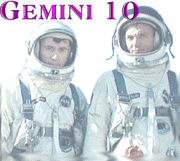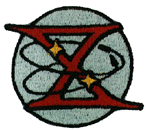
|

|
This page last updated |

|

|
This page last updated |

Gemini 10
GTA-10
July 18-21, 1966
1 2 3 4 5 6 7 8 9 10 11 12 13 14 15 Links 
Rendezvous-EVA Gemini X Set For July 18 Launch
Manned Spacecraft Center Space News Roundup - June 24, 1966The launch of the Gemini X mission has been scheduled for no earlier than July 18 at Cape Kennedy, Fla.
The three-day mission will begin with the launch of the Agena Target vehicle by an Atlas booster about 2:40 pm CST. The Gemini X spacecraft will be launched about 4:30 pm CST. The Agena will be inserted into a 185-mile circular orbit and the Gemini into a 100 by 168-mile elliptical orbit.
Primary crew for the mission is John W. Young, command pilot, and Michael Collins, pilot. Backup crew is Alan L. Bean, command pilot, and Clifton C. Williams, pilot.
Young, a Navy Commander, was pilot on the first manned Gemini flight, Gemini III, March 23, 1965. Collins, an Air Force Major, Bean, a Navy Lieutenant Commander, and Williams, a Marine Corps Major, have not made space flights.
Plans for the Gemini X mission include rendezvous, docking and extravehicular activity. The Gemini X spacecraft is scheduled to rendezvous and dock with its target vehicle and if possible to achieve a dual rendezvous with the Agena launched in the Gemini VIII mission March 16.
The first rendezvous is scheduled in the fourth revolution over South Africa with docking following a period of station keeping.
The crew will maneuver the docked vehicles, using the Agena target vehicle propulsion system, into a position to accomplish a dual rendezvous with the Gemini VIII Agena at an altitude of approximately 247 miles. The crew will undock from the Gemini X Agena and use the spacecraft control and propulsion systems to initiate the final phase of the dual rendezvous with the Gemini VIII Agena.
Two spacecraft extravehicular activities are planned for Gemini X. The first is a stand-up EVA in which the pilot will be standing on his seat with his upper body extending through the open hatch of the spacecraft. During the 55 minutes of this stand-up EVA the pilot will perform the ultra-violet astronomical experiment, color patch photography experiment, synoptic terrain and synoptic weather photography.
During the umbilical EVA the pilot will evaluate the operation of the Extravehicular Life Support System (ELSS, chestpack), the Hand-Held Maneuvering Unit (HHMU), evaluate maneuvering in space and perform two micrometeoroid collection of experiments. He will be using a 50-foot umbilical throughout this 55 minutes of EVA.
Sixteen experiments are to be performed during the Gemini X mission: Star Occulation Navigation (D-5), Ion Sensing Attitude Control (D-10), Tri-Axis Magnetometer (MSC3), Lunar Ultraviolet Spectral Reflectance (MSC-5), Beta Spectrometer (MSC-6), Bremsstrahlung Spectrometer (MSC-7), Color Patch Photography (MSC-6), Landmark Contrast (MSC-12), Zodical Light Photography (S-1), Synoptic Terrain Photography (S-5), Synoptic Weather Photography (S-6), Micrometeorite Grater Collection (S-10), Micrometeorite Collection (S-12), Ultraviolet Astronomical Camera (S-13), Ion Wake Measurement (S-26), and Bioassays of Body Fluids (M-5).
Landing of Gemini X is planned at the beginning of the 45th revolution in the Western Atlantic recovery zone.

1 2 3 4 5 6 7 8 9 10 11 12 13 14 15 Links
Home Biography Missions Appearances Bibliography Site Map Critique this site!
John W. Young - American & International Hero Title Page
Page created by Dana Holland - webmaster @ johnwyoung.org
Dana's Page
This site is for informational and educational purposes only. It is NOT sanctioned by John Young, NASA, or Navarro College.